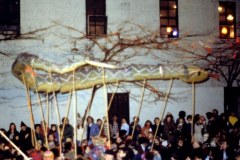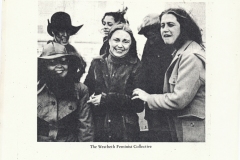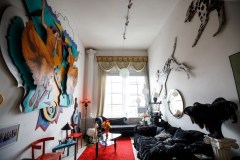Westbeth Artists Housing was conceived in the 1960’s as a partial solution to the acute need to provide affordable housing and studios for artists and their families. In so doing, it became one of the first examples of adaptive reuse of industrial buildings for artistic and residential use in the United States.
Located in New York City in Manhattan’s Far West Village, it is a complex of 3 buildings of which the main building is for artists housing, the L Building, which is the New School, and the I Building, which has artists studios and commercial spaces. It originally was built as a complex of 13 buildings in 1868 for Western Electric. In 1898 Bell Laboratories took over and turned it into one of the world’s most important research centers. It was here that the first talking movie, the condenser microphone, the first TV broadcast, and the first binary computer were demonstrated. In 1966 Bell Labs relocated outside of Manhattan.
With innovative funding spearheaded by the J. M. Kaplan Foundation and Roger Stevens of the National Endowment for the Arts, Westbeth became an ambitious renovation project designed to create 383 live-work spaces for artists of all disciplines and their families under the direction of developer Dixon Bain. Joan Davidson of the J. M. Kaplan Foundation supervised the conversion of the building and its operation. Richard Meier was the renovation architect. Westbeth opened in 1970.
 Westbeth was added to the National Registrar of Historic Places on Dec 8, 2009. Subsequently, the New York State Historic Preservation Board placed Westbeth on the State Registrar of Historic Places on December 8, 2009.
Westbeth was added to the National Registrar of Historic Places on Dec 8, 2009. Subsequently, the New York State Historic Preservation Board placed Westbeth on the State Registrar of Historic Places on December 8, 2009.
On October 25, 2011 the NYC Landmarks Preservation Commission unanimously designated Westbeth Artists Housing a New York City landmark. Significant research on Westbeth’s behalf was done by the Greenwich Village Society for Historic Preservation.
Westbeth is owned by the not-for-profit Westbeth Housing Development Fund Corporation, administered by the Westbeth Board of Directors. Cultural events are sponsored by the Westbeth Artists Residents Council, a tenant-elected not-for-profit organization. For further info see Westbeth Artists Residents Council.
In addition to its residential component, Westbeth also contains large and small commercial spaces, performance and rehearsal spaces, and artists studios both individual and communal, such as the Westbeth Sculpture Studio, Westbeth Painters Studios, Westbeth Ceramics Studio, and the Westbeth Print Studio.
Westbeth is also home to major cultural organizations, including the New School for Drama, The Martha Graham Center of Contemporary Dance, and the Kitchen. The first LGBT synagogue in New York, Congregation Beth Simchat Torah, was here for almost 40 years.
Bell Labs photos reprinted with permission of Alcatel-Lucent USA Inc
Westbeth Through the Years
Click image to start the slide show #1, Click page number at bottom for slide shows #2 and #3

























